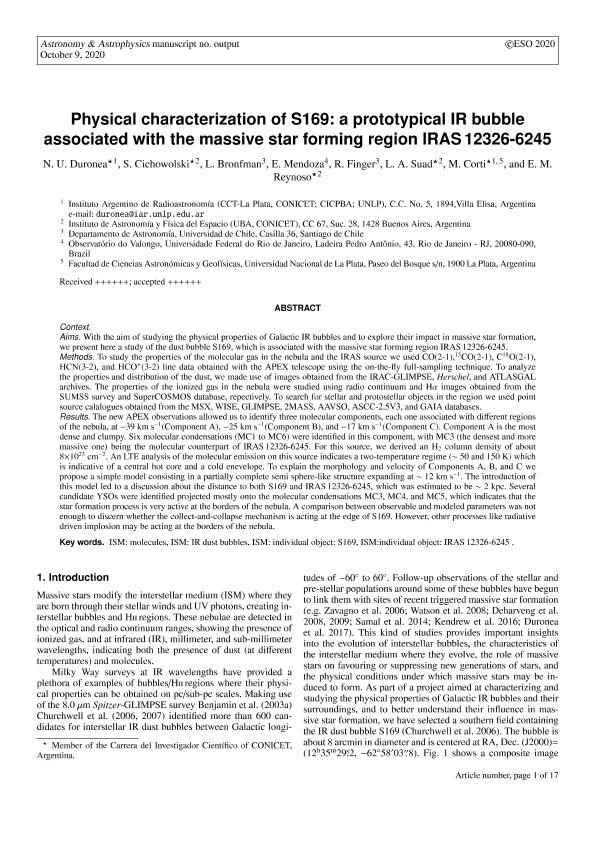Artículo
Physical characterization of S169: a prototypical IR bubble associated with the massive star-forming region IRAS 12326-6245
Duronea, Nicolas Urbano ; Cichowolski, Silvina
; Cichowolski, Silvina ; Bronfman, L.; Mendoza, E.; Finger, R.; Suad, Laura Andrea
; Bronfman, L.; Mendoza, E.; Finger, R.; Suad, Laura Andrea ; Corti, Mariela Alejandra
; Corti, Mariela Alejandra ; Reynoso, Estela Marta
; Reynoso, Estela Marta
 ; Cichowolski, Silvina
; Cichowolski, Silvina ; Bronfman, L.; Mendoza, E.; Finger, R.; Suad, Laura Andrea
; Bronfman, L.; Mendoza, E.; Finger, R.; Suad, Laura Andrea ; Corti, Mariela Alejandra
; Corti, Mariela Alejandra ; Reynoso, Estela Marta
; Reynoso, Estela Marta
Fecha de publicación:
15/02/2021
Editorial:
EDP Sciences
Revista:
Astronomy and Astrophysics
ISSN:
0004-6361
e-ISSN:
1432-0746
Idioma:
Inglés
Tipo de recurso:
Artículo publicado
Clasificación temática:
Resumen
Aims. With the aim of studying the physical properties of Galactic IR bubbles and to explore their impact in massive star formation, we present a study of the IR bubble S169, associated with the massive star forming region IRAS 12326-6245. Methods. We used CO(2-1),13CO(2-1), C18O(2-1), HCN(3-2), and HCO+ (3-2) line data obtained with the APEX telescope using the on-the-fly full sampling technique to study the properties of the molecular gas in the nebula and the IRAS source . To analyze the properties and distribution of the dust, we made use of images obtained from the IRAC-GLIMPSE, Herschel, and ATLASGAL archives. The properties of the ionized gas in the nebula were studied using radio continuum and Hα images obtained from the SUMSS survey and SuperCOSMOS database, respectively. In our search for stellar and protostellar objects in the region, we used point source calalogs obtained from the MSX, WISE, GLIMPSE, 2MASS, AAVSO, ASCC-2.5V3, and GAIA databases. Results. The new APEX observations allowed us to identify three molecular components, each one associated with different regions of the nebula, namely: at −39 km s−1 (component A), −25 km s−1 (component B), and −17 km s−1 (component C). Component A is shown to be the most dense and clumpy. Six molecular condensations (MC1 to MC6) were identified in this component, with MC3 (the densest and more massive one) being the molecular counterpart of IRAS 12326-6245. For this source, we estimated an H2 column density up to 8×1023 cm−2 . An LTE analysis of the high density tracer lines HCO+ (3-2) and HCN(3-2) on this source, assuming 50 and 150 K, respectively, indicates column densities of N(HCO+ ) = (5.2 ± 0.1) × 1013 cm−2 and N(HCN) = (1.9 ± 0.5) × 1014 cm−2 . To explain the morphology and velocity of components A, B, and C , we propose a simple model consisting of a partially complete semisphere-like structure expanding at ∼ 12 km s−1 . The introduction of this model has led to a discussion about the distance to both S169 and IRAS 12326-6245, which was estimated to be ∼ 2 kpc. Several candidate YSOs were identified, projected mostly onto the molecular condensations MC3, MC4, and MC5, which indicates that the star-formation process is very active at the borders of the nebula. A comparison between observable and modeled parameters was not enough to discern whether the collect-and-collapse mechanism is acting at the edge of S169. However, other processes such as radiative-driven implosion or even a combination of both mechanisms, namely, collect-and-collapse and radiative-driven implosion, could be acting simultaneously in the region.
Palabras clave:
HII REGIONS
,
ISM: BUBBLES
,
ISM: KINEMATICS AND DYNAMICS
,
ISM: MOLECULES
Archivos asociados
Licencia
Identificadores
Colecciones
Articulos(IAFE)
Articulos de INST.DE ASTRONOMIA Y FISICA DEL ESPACIO(I)
Articulos de INST.DE ASTRONOMIA Y FISICA DEL ESPACIO(I)
Articulos(IAR)
Articulos de INST.ARG.DE RADIOASTRONOMIA (I)
Articulos de INST.ARG.DE RADIOASTRONOMIA (I)
Citación
Duronea, Nicolas Urbano; Cichowolski, Silvina; Bronfman, L.; Mendoza, E.; Finger, R.; et al.; Physical characterization of S169: a prototypical IR bubble associated with the massive star-forming region IRAS 12326-6245; EDP Sciences; Astronomy and Astrophysics; 646; 15-2-2021; 1-18
Compartir
Altmétricas



